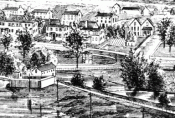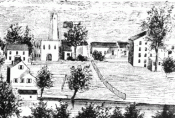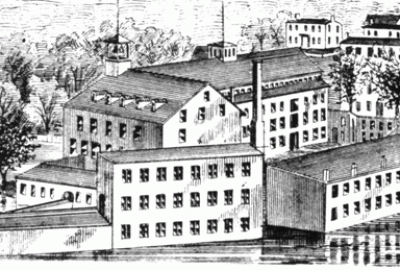Brief History of Eastampton Township , NJ
1880 through 2006 – 125+ Years
The local area that we presently know as Eastampton Township was first periodically inhabited by tribes of the Delaware Indians. This period was around 1683. The Indians called the area Alumhatta. During the period of colonization, the Indians were forced to move from the area which was the standard operating procedure during colonial conquest.
The first “official” owner of the property was Henry Stacy. This was as a result of surveys conducted at the time by Proprietors of the Province of West Jersey . After Mr. Stacy’s death in 1686, the original 500 acre tract was purchased by Sarah Parker. Ms. Parker was a widow and had five children, and they lived on the property for 44 years.
Mr. Jacob Parker, supposedly a descendent of the widow Parker, purchased 37 acres in order to build a dam on the Rancocas Creek, which then led to future industrial activity in the area. “Parker Mills” was operating in 1790, when a neighbor of Jacob’s, Thomas Merritt, also was interested in getting into the sawmill business. As a result, lawsuits developed between the two for the next 12 years, ending when Mr. Merritt died and Mr. Parker when bankrupt in 1802.

The Parker property was then sold at a Sheriff’s auction to John Mullen. Mr. Mullen operated a sawmill and two gristmills until 1816. In that year, Mr. Charles French purchased the property and continued to operate the Parkers Mills for the next 15 years. In 1831, Mr. French and his co-owner at the time, William Roberts sold the property to Jonathan and Samuel Shreve.
The Shreve brothers transformed the mills into an industrial village called “Shreveville”.
They expanded the mills area by redirecting the Rancocas Creek to increase their water flow. The Shreves were able to prosper and by 1850 operated a cotton spinning and weaving factory, a spool cotton factory and several other businesses. Supposedly, the first spooled cotton was spun at this complex. At this time, what is now known as the Smithville Mansion was constructed along with 60 worker’s houses. The Shreve’s also had built a general store, blacksmith shop, machine shop and several storage sheds. The Shreve brothers prospered until a dramatic event took place in 1850, the introduction of the steam engine. This invention led to the decline of rural water-powered industries, and the relocation of industrial activity to urban areas. This turn of events led to the brothers being in debt in 1854 by nearly $1,000,000, and in declining health. By 1858 both brothers were deceased and their property sold. During the next seven years, the property stayed vacant, and not until after the Civil War was there any interest in the property.

At that time an inventor, politician, industrialist and bigamist by the name of Hezekiah B. Smith arrived, and the year was 1865. This is the year that Hezekiah and his “second” bride, Agnes Gilkerson moved to the Shreveville site where he bought 45 acres for $20,000. This was the start of fulfilling his dream to develop, and build a model company town. Mr. Smith redeveloped the area and by the late 1870’s “Smithville” was taking shape. The site now contained shops, factories, a foundry, school house, park and accommodations for 250 people. Recreation was available at the village park and picnic grove, and cultural events were scheduled at the village opera house.
In 1877, Smith had his company incorporated and proceeded to charter the H. B. Smith Machine Company. In 1878, Smith ran for public office and became Congressman Smith. He was defeated in his bid to win a second term (1880), because during his first term his bigamous activities were uncovered. Later that year, George Pressey arrived and the start of the bicycle crazed began. Their product, the “Star” bicycle, was unique in that it had a small front wheel and the large wheel in the rear. Other designs at the time were just the opposite.
Mr. Smith was very active in getting the people in his area to petition the New Jersey Legislature to create a new township. Shortly after that, On March 9, 1880 at the Township meeting; Eastampton was officially incorporated as a township in the state of New Jersey per Senate Bill #14.
In 1881, his wife Agnes died and left him alone and heartbroken. A heart attack and subsequent pneumonia took the life of “the old man of Smithville”, and he passed away on November 3, 1887.
At the time of his death, his company had developed prototypes of a motocycle (steam powered bicycle), automobile, two wheeled bicycle, roller skates and helicopter. Also in this same year, Mr. Arthur Hotchkiss came upon the scene in Smithville. Professor Hotchkiss was an inventor and he came to Smithville to develop the first bicycle railroad in the United States . The railroad was constructed and ran the 1.8 miles from Smithville to Mount Holly and back. The special railroad lasted 17 years until its demise in 1898.
Eastampton remained a farmland for a long time, and there were apple trees all over the place, a peach orchard where Gregory’s Center now exists, and over half of the land was dairy farms. The first public school was built around 1941 and had only three rooms. In 1970 the population of Eastampton was 2,284 living in an area of 5.63 square miles. About this time US Homes started building houses in this same 5.63 square miles, and we now have a population of approximately 6500. The new houses that were constructed were built around an old farmhouse owned by the Cliver family. This house was built in 1835 and has survived two fires. After the last fire, the township “fathers” decided to acquire the property and locate on the site what is now know as the Manor House which serves as Eastampton Township ’s Municipal Building.

